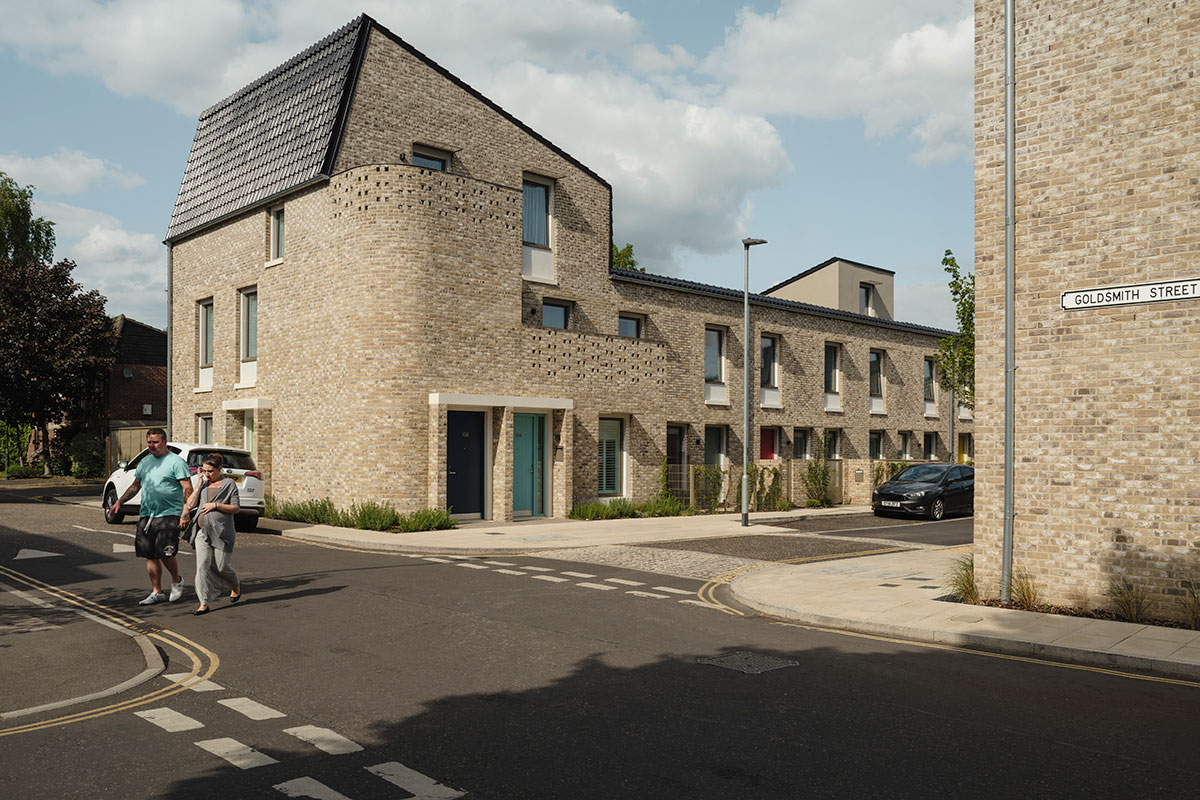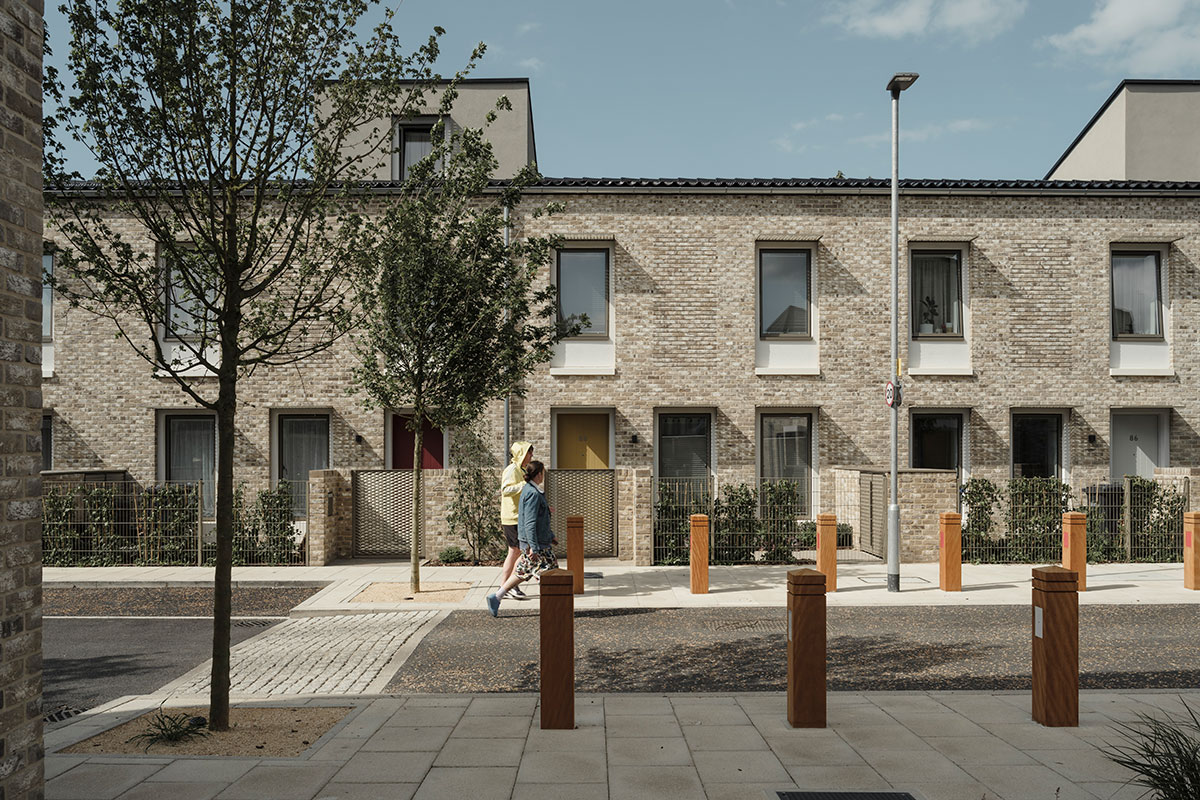You are viewing 1 of your 1 free articles
The gold standard: how a council housing scheme won architecture’s biggest prize
Two weeks ago, a social housing scheme won the Stirling Prize for the first time. Will Hatchett heads to Norwich to find out why. Photography by Tim Crocker
“Groundbreaking”, “a beacon of hope” and “modest masterpiece” were some of the accolades given to the Goldsmith Street development in Norwich after it won the Royal Institute of British Architects’ (RIBA) Stirling Prize two weeks ago.
The Stirling Prize means that the 94-home council scheme, with its four rows of high-tech, brick-built houses and flats, is now officially “Britain’s best building”. It is the first social housing scheme to secure the title in the prize’s 23-year history.
It follows on from other success – it was the first winner of RIBA’s Neave Brown Award for Housing last year – and it has put Norwich and council housebuilding firmly in the spotlight.
In the days following the prize, this part of inner-city Norwich, close to its sought-after “golden triangle” area, was besieged by journalists.
Curious representatives from other councils, civil servants from two government departments and housing minister Esther McVey were also among the visitors.
These are eco-homes, built to a high specification. The houses all have south-facing elevations and gently pitched roofs, angled to catch maximum sunlight. This, combined with triple glazing, excellent insulation and internal heat recovery systems, makes them extremely cheap to heat.
Following a traditional street pattern, the development has generous communal areas and secure alleyways protected by keypads. Each house has its own front and rear garden, and flats have their own front doors and balconies.
Most of the houses have two bedrooms, and these are in high demand locally as residents scale down because of the bedroom tax. More than 10% of units are built to the Lifetime Homes Standard, meaning they meet the 16 expected standards that make homes more easily adaptable during the lifetime of residents.
If the aesthetics of Goldsmith Street derive from energy efficiency, numerous tiny details indicate judicious design choices. The black roof tiles, the carefully patterned brickwork, the metal grilles used for solar shading, the gates and bin stores all show a sharp attention to detail.
This combination of strong design and sustainability principles has left some billing it as “the future of council housing”.
When the Stirling Prize winner was announced in London, there was a deafening roar of approval, recalls Gail Harris, deputy leader and cabinet member for social housing at Norwich City Council.
Last year, Norman Foster’s glitzy £1.3bn Bloomberg building had scooped the prize – a far cry from the £14.7m council estate in Norwich and a reflection of a change in the national zeitgeist, perhaps?
Speaking to Inside Housing, Ms Harris sits on a bench in an open space in the centre of the development. She does not hide her pride and delight at the trophy. After all, it has done much to raise the profile of Norwich and council housebuilding.
She says: “It’s a really positive story, isn’t it? A scheme which is 100% social housing, paid for from Right to Buy receipts and the Housing Revenue Account, and built to Passivhaus Standard has won a national award. Council housing has never even been nominated before, let alone won the Stirling Prize.”
The development, she explains, was launched in 2009, atypically by means of a RIBA architectural competition. Five firms were whittled down to two.
Unusually, it was a local resident who cast the final vote. Clerkenwell-based architects Mikhail Riches won the contract, for the design based on retaining streets rather than the more obvious solution: apartment blocks.
The 94 social homes at Goldsmith Street are built to the Passivhaus Standard
After an open-day consultation, ground was broken in 2017. The first tenants, selected from Norwich Council’s choice-based allocation system, moved in December last year.
Ms Harris says: “Something like this is not just about building – it’s about creating a community. You can already see that people are doing their own bits of gardening. They can open their back gate and their children can socialise safely. What we’re doing is reducing social isolation.”
Success is also about saving money. The homes’ Passivhaus specification can mean a 70% reduction in fuel bills. Ms Harris says: “Some of our residents were choosing between heating their houses and paying their rent and eating.”
However, surely a project with such a high specification equates to an extremely expensive project?
Not necessarily, explains Andrew Turnbull, senior housing development officer at Norwich Council. He says: “This scheme cost about 10% more than a normal procurement. But you do need to think about whole-life costing.
“We will own these properties for a significant period of time and we’ve used high-spec materials which won’t need replacing so often. So, over 30 years that 10% will come down.
“Also, Passivhaus homes have a low void and turnover rate because tenants have low energy bills and can afford to pay their rent.”
In 2016, the project hit a problem when it was running up to £2m over budget. The issue was solved by “value engineering”.
Mr Turnbull explains: “We decided to finish the backs of the houses with render, not brick. We dropped a couple of dormers and we changed the roof from zinc sheet to tiles – that on its own saved us £300,000.”
He adds that it was the same supplier that sourced double interlocking tiles from Germany that could cope with the scheme’s shallow-pitched roofs without falling off, and obtained a great price on gault-style yellow bricks from Belgium.
Mr Turnbull says: “Their red lines were exactly the same as ours – maintaining the Passivhaus Standard and retaining the number of units while not sacrificing aesthetics.”
David Mikhail, founding director of Mikhail Riches, explains that the job was let on a traditional joint contracts tribunal contract, with the architect being the contract administrator.
This is different from the standard design and build contracts usually used on projects like this, where contractors often try to stay in budget at all costs and where design principles can sometimes be compromised as margins become tight.
Mr Mikhail says that both parties shared the same objective of achieving the highest standards within the contract price: £1,850 per square metre.
Such partnerships, he tells Inside Housing, can deliver premium standards for competitive rates. He says: “A lot of my clients have been burned by design and build – the low quality and the lack of control.
“You don’t know what you are going to get until it’s too late. [Norwich Council was] heavily involved.”
Following Goldsmith Street, Mikhail Riches has won a contract to deliver 600 Passivhaus homes on four or five sites for City of York Council.
Ms Harris comments: “The ethos of the architect was very much same as ours: to get the best possible homes.”
While many developers build new homes as small as they can, here the intention was the opposite. Mr Turnbull explains: “Guidance specifies 76 sq m for a two-bedroom property, we build ours to 90 sq m.”
He adds: “If the government started to legislate for higher space standards in new build and permitted development, it would bring costs down and standards up.”
So will there be more, similar schemes in Norwich, which has a 100-year history of building affordable housing, since the Mile Cross Estate of 1920? And does Goldsmith Street give us a look into the future of council housebuilding?
The future, Ms Harris says, is unclear. It depends on political decisions.
Norwich did not build any council housing between 1992 and 2014. Labour-controlled since 2012, it has a retained council stock of just under 15,000 homes but that is diminishing, because of the Right to Buy, at 140 to 150 units a year – a rate that increased significantly when the discount cap was raised in 2012.
Its waiting list stands at 4,000 – a number that Ms Harris considers to be shockingly high.
She explains: “We can only fund 30% of our new build with our retained receipts. We have to find the rest of the money and we have to use the retained receipts within three years. If you don’t use them, you have to pay the money back to the government with interest.”
In the world that she would like, shared by many others in council housing departments, councils would be able to spend 100% of their receipts or even, as in Wales and Scotland, the Right to Buy would be abolished.
Policy indications from the current government are not pointing in that direction.
But it is the hope that Goldsmith Street can inspire where Ms Harris feels the Stirling Prize win could have the biggest impact.
“If Goldsmith Street can give encouragement to other councils to be ambitious and bold, that’s great,” she says. “It’s so important. Everybody should have a home like this.”
100 Years of Council Housing: what Inside Housing is doing
One hundred years ago, a piece of legislation led to the birth of council housing. Gavriel Hollander introduces Inside Housing’s celebration of the centenary of the Addison Act.
It is so ingrained in our national consciousness that it is hard to imagine just how radical the idea of local authority built and funded housing must have seemed a century ago. Before World War I, almost all housing in the UK was built by private developers (albeit with some notable municipal exceptions in major cities). Given this, it is unsurprising that both quality and consistency of delivery were variable.
The post-war introduction of subsidies for councils to solve the blight of slum estates was supposed to right a wrong and – in the words of then-prime minister David Lloyd George – provide “homes fit for heroes”.
The so-called Addison Act – the very first housing act passed in this country, named after its sponsor Dr (later Lord) Christopher Addison – received royal assent exactly 100 years ago this month.
It may never have achieved its aspiration of delivering 500,000 homes (something that may sound familiar to modern-day watchers of government housing policy) but it was the start of a movement.
New estates began to crop up across the country, built in accordance with recommendations from the Tudor Walters Report, which was produced to parliament in November 1918. This built on the ‘Garden City Principles’ and suggested a number of improvements to the standard of public housing. These included limiting the length of terraced-housing blocks, mandating a minimum number of rooms and providing indoor bathrooms.
“The post-war introduction of subsidies for councils to solve the blight of slum estates was supposed to right a wrong and – in the words of the prime minister David Lloyd George – provide ‘homes fit for heroes’”
Although the abandonment of subsidy in 1921 and a change of government the following year curtailed the immediate growth of council-built housing, the seed had been sown.
This month Inside Housing celebrates the centenary of the Addison Act with a month-long series of articles looking at how it transformed the social fabric of the country and created the housing sector we know today.
Over the course of this month, we visit four estates, each symbolising a different era of council housebuilding. We also take a look at whether new-found financial freedom for local authorities could be the catalyst for a new generation of estates.
To kick off the series, acclaimed social historian John Boughton visits one of the first estates made possible by Lord Addison’s historic legislation: Sea Mills in Bristol. We then travel to Stevenage to look at how the damage to Britain’s inner cities during the Blitz led to the new town movement and a fresh wave of estates through the 1950s and 1960s.
Martin Hilditch, editor of Inside Housing, takes a trip to Hulme in Manchester to examine how the private and public sector had to work together in the 1980s to deliver a regeneration project, which is still thriving more than 30 years later.
Finally, we go to Nottingham and look at one council with grand ambitions to provide housing to a new generation of tenants.
There may still be myriad challenges to face when it comes to providing good-quality, genuinely affordable housing for those most in need, but without the passing of an act of parliament 100 years ago, the sector we work in today may never have come to exist. That alone is worth celebrating.
To read more about the act, go to: www.insidehousing.co.uk/AddisonAct
















